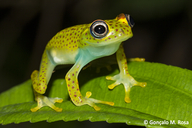|
Description
M 21-23 mm, F 32 mm. Tibiotarsal articulation reaches at least the nostril and often beyond snout tip. Hand with some webbing, foot webbing 1(0), 2i(0.5), 2e(0), 3i(1.25), 3e(0.5), 4i/e(2), 5(0.5). Dorsal skin smooth. Dorsally green, sometimes with traces of yellow dorsolateral lines, and always with numerous, evenly spaced small red dots. Tips of fingers and toes greenish. Outer iris area turquoise, iris periphery blue (Glaw and Vences 2007).
Similar species: B. erythrodactylus differs by having red colour on the tips of fingers and toes (Glaw and Vences 2007).
Distribution and Habitat
Country distribution from AmphibiaWeb's database: Madagascar
An’Ala, Andasibe, Mananara, Mantadia, Ranomafana (Vohiparara, Imaloka, Maharira forest) (Glaw and Vences 2007). It occurs at 300-900 m asl in pristine rainforest (Vences et al. 2008).Life History, Abundance, Activity, and Special Behaviors
Males call at night from 1-3 m above the ground in the vegetation next to streams in rainforest. The call is a short, high-pitched note consisting of two, sometimes three, clicks (Glaw and Vences 2007). Breeding occurs in the streams (Vences et al. 2008)
Trends and Threats
A common, widely distributed species, but threatened by habitat loss due to increasing subsistence agriculture, logging, charcoal manufacture, invasion and spread of eucalyptus, increased grazing and expanding human settlement. Requires pristine forest. Occurs in several protected areas (Vences et al. 2008). Possible reasons for amphibian decline General habitat alteration and loss
Habitat modification from deforestation, or logging related activities
Intensified agriculture or grazing
Urbanization
Subtle changes to necessary specialized habitat
Comments
Taken partly from Glaw and Vences (2007), with permission.
References
Glaw, F., and Vences, M. (2007). Field Guide to the Amphibians and Reptiles of Madagascar. Third Edition. Vences and Glaw Verlag, Köln.
Vences, M., Glaw, F., and Nussbaum, R. (2008). Boophis tasymena. In: IUCN 2008. 2008 IUCN Red List of Threatened Species. www.iucnredlist.org. Downloaded on 24 March 2009.
Originally submitted by: Miguel Vences and Frank Glaw (first posted 2009-03-17)
Edited by: Kellie Whittaker (2009-03-24)Species Account Citation: AmphibiaWeb 2009 Boophis tasymena <https://amphibiaweb.org/species/6038> University of California, Berkeley, CA, USA. Accessed Jun 12, 2025.
Feedback or comments about this page.
Citation: AmphibiaWeb. 2025. <https://amphibiaweb.org> University of California, Berkeley, CA, USA. Accessed 12 Jun 2025.
AmphibiaWeb's policy on data use.
|
